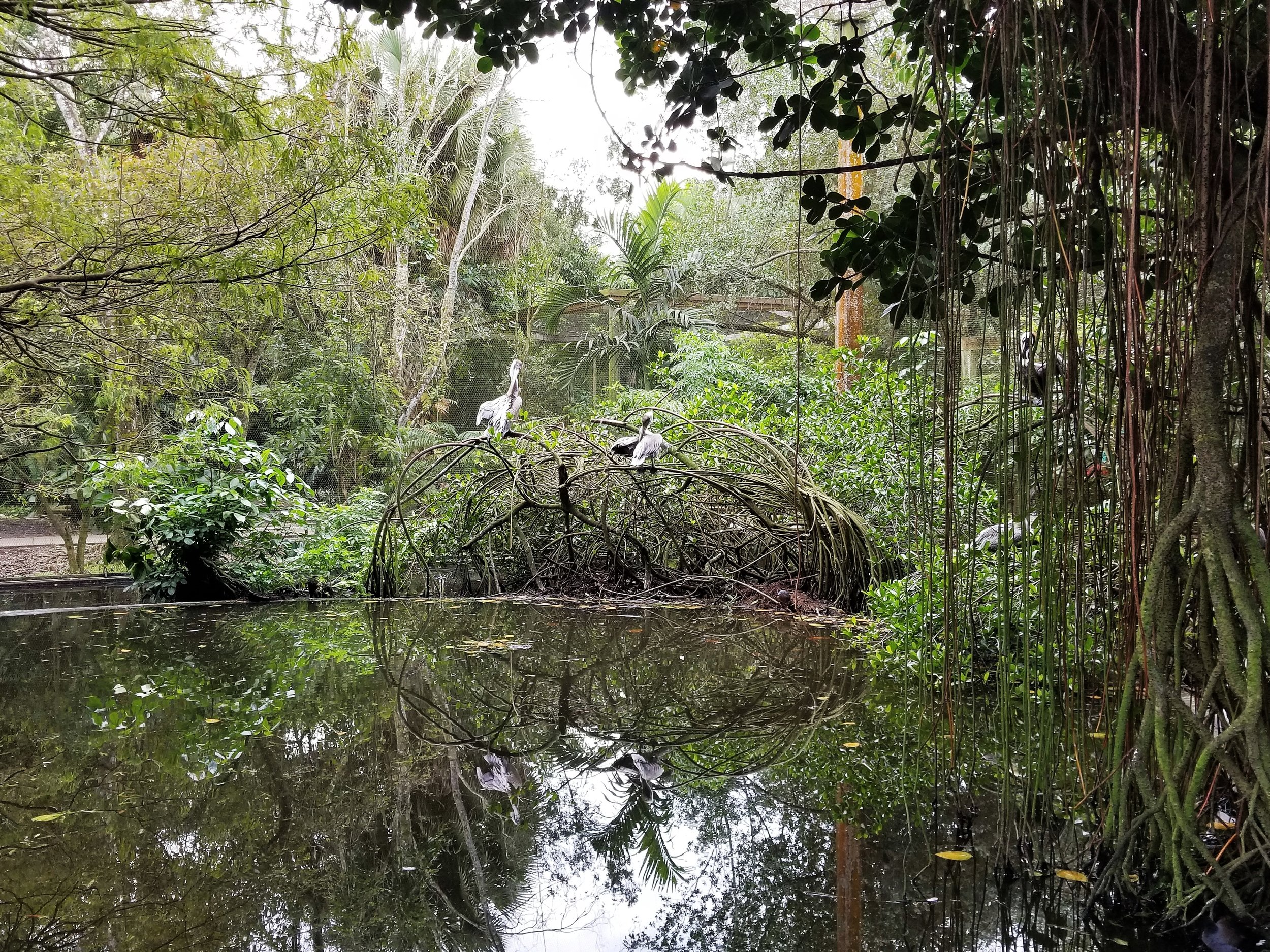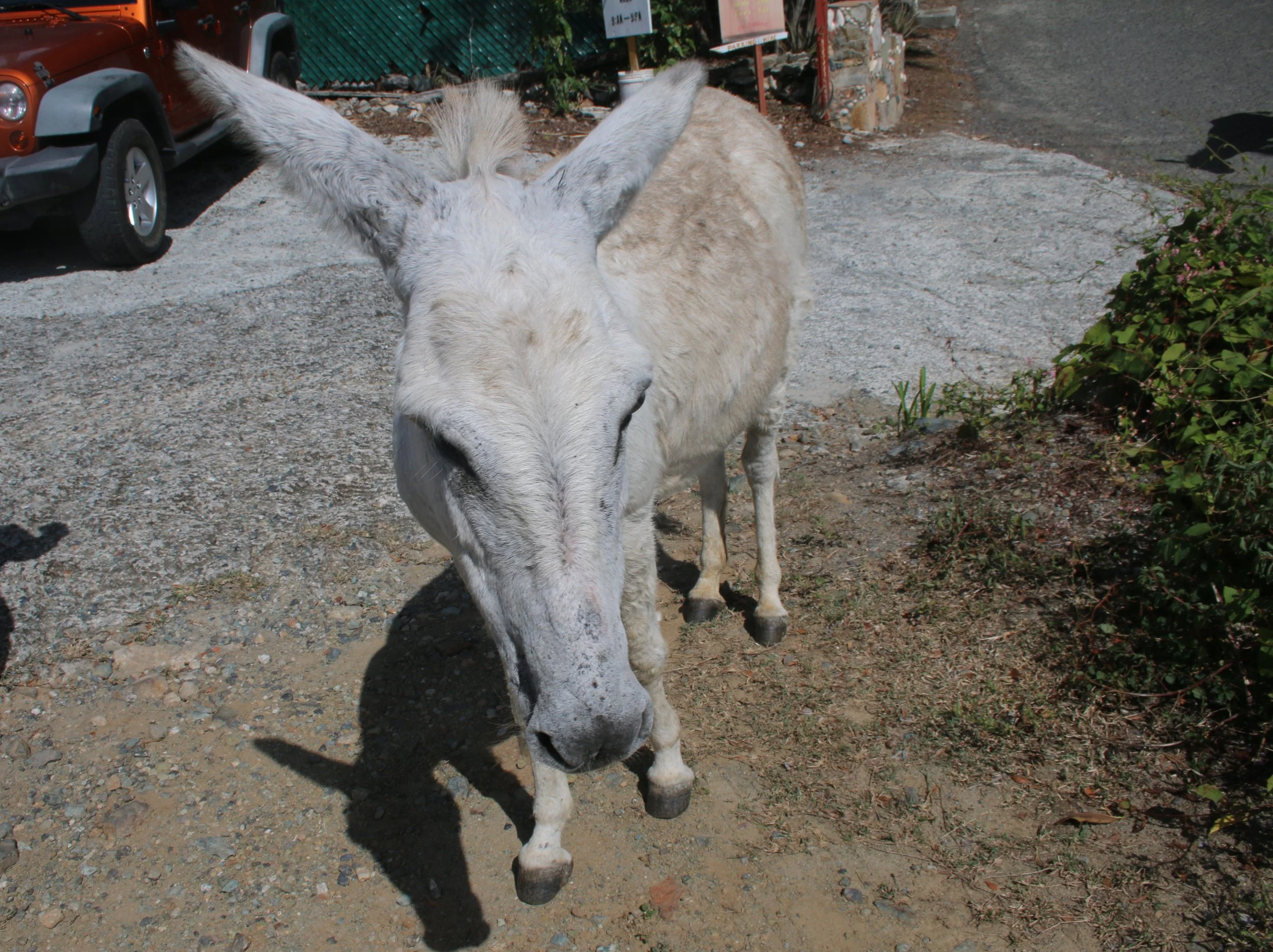Find Flamboyant, Flummoxing, Fascinating, and Fun Florida Flamingos at Flamingo Gardens and Everglades Wildlife Sanctuary in Fort Lauderdale (Featuring Flamingo Facts)
An alliterative article
Florida and flamingos go together like chips and salsa. With this easily recognizable bird found on everything from t-shirts to restaurant menus (FF1), many people assume that flamingos are as much a part of Florida as beaches and sunshine, but that wasn’t always the case. Not that long ago the number of flamingos living in the state was incredibly low. However, Florida’s flamingos have made an amazing come back and a beautiful and immersive place to find them is at Flamingo Gardens and Everglades Wildlife Sanctuary in Davie near Fort Lauderdale.
Florida champion trees are a main feature at Flamingo Gardens. Photo by Carrie Dow.
The bird species known as Caribbean flamingos are found in wetlands that border the Caribbean Sea: Florida, Cuba, The Bahamas, the Yucatan Peninsula, and northern South America. These tall, flamboyantly pink (FF2) waterfowl are the epitome of both awkwardness and grace when seen walking on their long, stick-like legs capped by knobby ankles (FF3) while their stately curved necks allow them to eat with their heads upside down. Flamingos were once abundant in the area that became Fort Lauderdale before a young couple, Floyd and Jane Wray, arrived from the Midwest in 1925 and purchased 320 acres of Everglades for horticultural use. They named the estate Flamingo Grove.
“Back in those days they say the birds used to block the sunlight there’d be so many of them flying around,” describes Michael Ruggieri, Flamingo Gardens’ Director of Animal Care. Many Florida birds are endangered because at the turn of the 20th century the state’s avian population was decimated by The Feather Trade. Tens of thousands of birds, including flamingos and red and white snowy egrets were hunted solely for their feathers for decorative use in the fashion industry – think fancy hats and feather boas. “They said the reddish egret was the most prolific of all the wading birds and now it’s one of the rarest,” Ruggieri added.
Pelicans inside the aviary at Flamingo Gardens. Photo by Carrie Dow.
Everglades development also led to habitat loss causing birds and other animals to disappear. Eventually wild flamingos vanished from the state, but their iconic status created an interesting situation. According to the National Audubon Society, South Florida’s wealthy began importing flamingos from The Bahamas as pets, including Mrs. Wray who kept 12 flamingos along with some peacocks. Those captive birds birthed and raised young who then flew off establishing themselves in various pockets of southeastern Florida. While the numbers will never be pre-Feather Trade levels, the unofficial symbol of Florida is holding its own (FF4).
Flamingos in a rookery pool at Flamingo Gardens. Photo by Carrie Dow.
Originally, the Wrays developed Flamingo Grove as an agricultural testing ground, planting a variety of orchard crops, mostly oranges but also other citrus and papayas and mangos, to see what would grow best in Florida’s subtropical climate. The Wrays, who lived in nearby Hollywood, built a second home on the grove’s highest spot under giant oak trees and loved to entertain and show people their beautiful trees and birds. They even invited the public to visit often hosting massive weekend BBQs serving upwards of 200 people. After Mr. Wray passed in 1959, Mrs. Wray created a foundation to save the land for future generations (she passed in 1969). By the time Ruggieri was hired in 1990, it had been renamed Flamingo Gardens and is now one of Florida’s oldest nature sanctuaries. Today, not only can visitors wander the lush botanical gardens and tour the Wrays’ house to see what South Florida looked like 100 years ago, they can also peruse a wildlife sanctuary that is home a variety of birds and other Florida animals including bear, panther, bobcats, turtles, alligators, crocodiles, and river otters. This combination of flora and fauna makes Flamingo Gardens unique.
Guests can tour the Wrays’ home built in the 1930s. Photo by Carrie Dow.
“For Broward County,” says Ruggieri, “we’re one of the only [botanical gardens] that has animals. And this place is really beautiful. When people finally find out about us, they’re like, you’ve been in my backyard for 40 years. And for the tourists. You don’t see trees like these. [They’re] not used to this.”
Walking through the center guests will be amazed at the gardens’ centerpiece, Florida’s largest cluster fig measuring over 54 feet in circumference and 102 feet tall. Ruggieri says Flamingo Gardens is home to 15 “Florida champion trees,” trees certified by the Florida Forestry Service as the largest of their species. Surrounding these amazing trees are winding paths leading to other areas filled with ferns, flowers, orchids, babbling brooks, and reflection ponds. The gardens recently hired an insect specialist who nurtures butterflies in a small wooden shed near the gardens’ wedding gazebo. When the pupa morph into adult butterflies, they get released into the gardens and have produced over 3,500 butterflies so far.
Guests can feed the birds at the rookery, including this colony of ibis. Photo by Carrie Dow.
Just beyond the champion cluster fig is the gardens’ other signature attraction, a 26,000-square foot aviary that Ruggieri helped design and build and contains five different Everglades ecosystems: Coastal prairie, mangrove swamp, cypress forest, hardwood hammock, and sawgrass prairie. The aviary houses some 250 birds spanning 40 species including egrets, ducks, herons, and pelicans, along with a turtle or two. A stream runs through the aviary leading to a central pond surrounded by shade trees and shrubs with leaves so thick people sometimes walk right past a perched bird and not even know it. Some of the birds, like the ducks, are curious and walk up to people, while others like the Great Blue Heron keep their distance and a watchful eye. White and brown pelicans are scattered on the grounds in feathery lumps with their large beaks and heads tucked under a wing for nap. Following the aviary’s walking path while watching and listening to the birds makes it a peaceful oasis in the city. The aviary and gardens are even fun to visit on Florida’s rare cloudy days because the trees provide cover from passing rainstorms.
Even though it’s inside an enclosure, this crocodile still looks menacing. Photo by Carrie Dow.
Many of the aviary’s birds were found injured and nursed back to health by local wildlife rescues before rehoming at the sanctuary. Ruggieri says the extra-large aviary provides a safe place for them to recoup. “When we get these injured birds, if they live in a mangrove swamp, they run straight for the mangroves because that’s what they’re used to,” he notes. “You see them get up into a tree and rouse, that’s where they fluff up all their feathers, which is a good sign. It means they’re comfortable.”
Flamingo Gardens plays a crucial role in providing chicks for release into the wild. The resident birds are comfortable enough to breed and staff keep watch over everything. The resulting offspring get placed into the wild, a practice run in conjunction with the Florida Fish and Wildlife Conservation Commission (FWC). Ruggieri estimates that most years Flamingo Gardens provides 250-300 birds to FWC for release.
One of the gardens’ North American river otters lounging around. Photo by Carrie Dow.
The gardens’ namesake flamingos hang out at an open-air pond that they share with a colony of ibis. This area and the ponds around it are called the rookery and used by free-flying birds for roosting, nesting, and breeding. Birds like storks, cranes, swans, and geese may come and go during the day, but return to nest at night. It’s also near the on-site café where visitors can enjoy lunch while bird watching or purchase small bags of food to feed the flamingos. The ibis enjoy the snacks as well and will follow anyone who has a bag.
Get close to brown and white pelicans inside the garden’s 26,000 square foot aviary. Photo by Carrie Dow.
Also around the rookery pools are the individual enclosures for the gardens’ larger residents including Josh the bear, alligators Elvis and Pricilla, a giant crocodile, and two bobcats who spend most of the day sleeping in the shade. A can’t miss enclosure is for North American river otters where Fast Eddie, Spanky, Patches, and Bella lounge around the grounds in between bursts of swimming in their private pool complete with waterslide. Bubba, the gardens’ Florida panther, has his own large enclosure near the tram station. These animals arrived at the gardens either because of injury or were kept illegally as pets, often in horrible conditions so for them Flamingo Gardens truly is a sanctuary.
Mike Ruggieri (center) shows two park visitors one of the gardens’ Florida champion trees. Photo by Carrie Dow.
Next to the aviary, there are smaller enclosures for birds of prey, such as hawks, eagles, and owls. These birds end up at the gardens through injury so their enclosures are a bit smaller because they either cannot or should not fly. Ruggieri says that he goes through 2,800 pounds of fish a month to feed all the birds. While he must buy the fish, food for the mammals and reptiles is donated. Places like Walmart and local grocery stores donate expired meat, fruits, and vegetables.
Ruggieri is easy to spot on the grounds especially when he’s driving his custom golf cart - a white 1940s Nash car with a silver bird hood ornament. Its antique look fits right in with the old Florida vibe of the gardens. Before he drives off in his cart, Ruggieri adds that Flamingo Gardens is for everyone.
“When you come to the gardens, you need to look really around,” Ruggieri encourages. “Most of the wildlife you see on the property was bred right here, but a lot of it didn’t stay on the property. By simply coming out and paying admission to the gardens, you’re helping our breeding release programs so these animals really belong to [everyone]. They’re not ours.”
To learn more or purchase tickets, visit https://www.flamingogardens.org/
3750 S. Flamingo Rd., Davie, FL, 954-473-2955
Entry fee is $21.95 for adults (12 and up) and $15.95 for children (3-11), 2 and under free. Discounts are available online and VIP and group tours are available along with rentals for birthdays, corporate events, and weddings.
Flamingo Facts
1. The flamingo is Florida Lottery’s mascot and featured on lottery tickets.
2. Caribbean Flamingos can grow up to five feet tall and get their pinkish/reddish coloring from carotene in the algae and brine shrimp they eat. Carotene is what makes carrots orange and turnips purple.
3. What looks like a backwards knee is the flamingo’s ankle. The flamingo’s knee is much higher near the body and covered by feathers.
4. Wildlife organizations are debating whether Florida’s flamingo populations can be considered ‘native’ since their ancestors came from elsewhere in the Caribbean. Current classifications are ‘captives’ or ‘non-natives’ because Florida’s populations were hunted to extinction. However, animals listed as captive don’t have the same protections as native under state and federal laws, so groups like Audubon are petitioning FWC to change the classification to protect these new populations.
A peacock passes by the entrance to Flamingo Gardens. Photo by Carrie Dow.
















